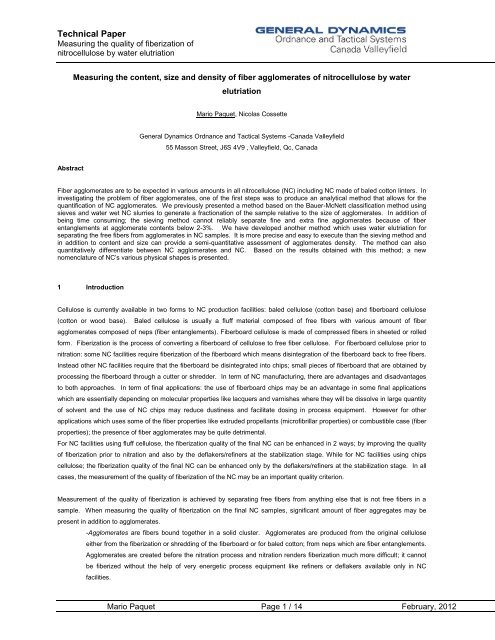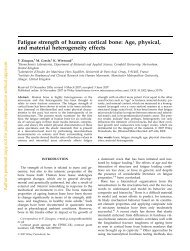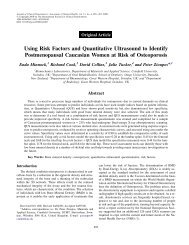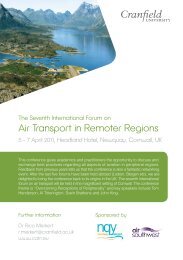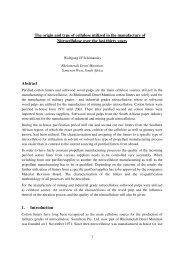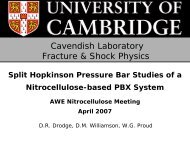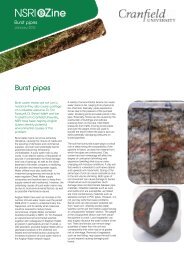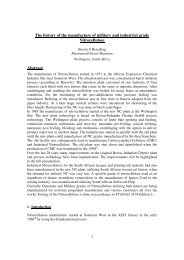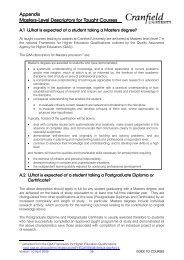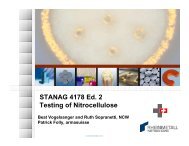Measuring the Content, Size and Density of Fiber
Measuring the Content, Size and Density of Fiber
Measuring the Content, Size and Density of Fiber
You also want an ePaper? Increase the reach of your titles
YUMPU automatically turns print PDFs into web optimized ePapers that Google loves.
Technical Paper<br />
<strong>Measuring</strong> <strong>the</strong> quality <strong>of</strong> fiberization <strong>of</strong><br />
nitrocellulose by water elutriation<br />
Abstract<br />
<strong>Measuring</strong> <strong>the</strong> content, size <strong>and</strong> density <strong>of</strong> fiber agglomerates <strong>of</strong> nitrocellulose by water<br />
elutriation<br />
Mario Paquet, Nicolas Cossette<br />
General Dynamics Ordnance <strong>and</strong> Tactical Systems -Canada Valleyfield<br />
55 Masson Street, J6S 4V9 , Valleyfield, Qc, Canada<br />
<strong>Fiber</strong> agglomerates are to be expected in various amounts in all nitrocellulose (NC) including NC made <strong>of</strong> baled cotton linters. In<br />
investigating <strong>the</strong> problem <strong>of</strong> fiber agglomerates, one <strong>of</strong> <strong>the</strong> first steps was to produce an analytical method that allows for <strong>the</strong><br />
quantification <strong>of</strong> NC agglomerates. We previously presented a method based on <strong>the</strong> Bauer-McNett classification method using<br />
sieves <strong>and</strong> water wet NC slurries to generate a fractionation <strong>of</strong> <strong>the</strong> sample relative to <strong>the</strong> size <strong>of</strong> agglomerates. In addition <strong>of</strong><br />
being time consuming; <strong>the</strong> sieving method cannot reliably separate fine <strong>and</strong> extra fine agglomerates because <strong>of</strong> fiber<br />
entanglements at agglomerate contents below 2-3%. We have developed ano<strong>the</strong>r method which uses water elutriation for<br />
separating <strong>the</strong> free fibers from agglomerates in NC samples. It is more precise <strong>and</strong> easy to execute than <strong>the</strong> sieving method <strong>and</strong><br />
in addition to content <strong>and</strong> size can provide a semi-quantitative assessment <strong>of</strong> agglomerates density. The method can also<br />
quantitatively differentiate between NC agglomerates <strong>and</strong> NC. Based on <strong>the</strong> results obtained with this method; a new<br />
nomenclature <strong>of</strong> NC’s various physical shapes is presented.<br />
1 Introduction<br />
Cellulose is currently available in two forms to NC production facilities: baled cellulose (cotton base) <strong>and</strong> fiberboard cellulose<br />
(cotton or wood base). Baled cellulose is usually a fluff material composed <strong>of</strong> free fibers with various amount <strong>of</strong> fiber<br />
agglomerates composed <strong>of</strong> neps (fiber entanglements). <strong>Fiber</strong>board cellulose is made <strong>of</strong> compressed fibers in sheeted or rolled<br />
form. <strong>Fiber</strong>ization is <strong>the</strong> process <strong>of</strong> converting a fiberboard <strong>of</strong> cellulose to free fiber cellulose. For fiberboard cellulose prior to<br />
nitration: some NC facilities require fiberization <strong>of</strong> <strong>the</strong> fiberboard which means disintegration <strong>of</strong> <strong>the</strong> fiberboard back to free fibers.<br />
Instead o<strong>the</strong>r NC facilities require that <strong>the</strong> fiberboard be disintegrated into chips; small pieces <strong>of</strong> fiberboard that are obtained by<br />
processing <strong>the</strong> fiberboard through a cutter or shredder. In term <strong>of</strong> NC manufacturing, <strong>the</strong>re are advantages <strong>and</strong> disadvantages<br />
to both approaches. In term <strong>of</strong> final applications: <strong>the</strong> use <strong>of</strong> fiberboard chips may be an advantage in some final applications<br />
which are essentially depending on molecular properties like lacquers <strong>and</strong> varnishes where <strong>the</strong>y will be dissolve in large quantity<br />
<strong>of</strong> solvent <strong>and</strong> <strong>the</strong> use <strong>of</strong> NC chips may reduce dustiness <strong>and</strong> facilitate dosing in process equipment. However for o<strong>the</strong>r<br />
applications which uses some <strong>of</strong> <strong>the</strong> fiber properties like extruded propellants (micr<strong>of</strong>ibrillar properties) or combustible case (fiber<br />
properties); <strong>the</strong> presence <strong>of</strong> fiber agglomerates may be quite detrimental.<br />
For NC facilities using fluff cellulose, <strong>the</strong> fiberization quality <strong>of</strong> <strong>the</strong> final NC can be enhanced in 2 ways; by improving <strong>the</strong> quality<br />
<strong>of</strong> fiberization prior to nitration <strong>and</strong> also by <strong>the</strong> deflakers/refiners at <strong>the</strong> stabilization stage. While for NC facilities using chips<br />
cellulose; <strong>the</strong> fiberization quality <strong>of</strong> <strong>the</strong> final NC can be enhanced only by <strong>the</strong> deflakers/refiners at <strong>the</strong> stabilization stage. In all<br />
cases, <strong>the</strong> measurement <strong>of</strong> <strong>the</strong> quality <strong>of</strong> fiberization <strong>of</strong> <strong>the</strong> NC may be an important quality criterion.<br />
Measurement <strong>of</strong> <strong>the</strong> quality <strong>of</strong> fiberization is achieved by separating free fibers from anything else that is not free fibers in a<br />
sample. When measuring <strong>the</strong> quality <strong>of</strong> fiberization on <strong>the</strong> final NC samples, significant amount <strong>of</strong> fiber aggregates may be<br />
present in addition to agglomerates.<br />
-Agglomerates are fibers bound toge<strong>the</strong>r in a solid cluster. Agglomerates are produced from <strong>the</strong> original cellulose<br />
ei<strong>the</strong>r from <strong>the</strong> fiberization or shredding <strong>of</strong> <strong>the</strong> fiberboard or for baled cotton; from neps which are fiber entanglements.<br />
Agglomerates are created before <strong>the</strong> nitration process <strong>and</strong> nitration renders fiberization much more difficult; it cannot<br />
be fiberized without <strong>the</strong> help <strong>of</strong> very energetic process equipment like refiners or deflakers available only in NC<br />
facilities.<br />
Mario Paquet Page 1 / 14 February, 2012
Technical Paper<br />
<strong>Measuring</strong> <strong>the</strong> quality <strong>of</strong> fiberization <strong>of</strong><br />
nitrocellulose by water elutriation<br />
-Aggregates conversely are fibers bound toge<strong>the</strong>r in less solid cluster <strong>and</strong> are created after <strong>the</strong> nitration process<br />
usually in <strong>the</strong> dewatering section where nitrated free fibers in slurry can be compress into hard lumps. Since <strong>the</strong><br />
dewatering process is <strong>the</strong> last stage <strong>of</strong> <strong>the</strong> NC manufacturing process; refining equipment cannot be used for <strong>the</strong>ir<br />
elimination. Those aggregates or lumps are typically much larger (10X) than agglomerates <strong>and</strong> be as high as 5% in<br />
some samples. These lumps have much lower mechanical resilience <strong>the</strong>n agglomerates <strong>and</strong> can usually be<br />
eliminated by most processing equipment in <strong>the</strong> propellant or combustible case process when taken into account.<br />
Figure 1<br />
The aggregates can easily be pulverized by ultra-sonication which is not <strong>the</strong> case with agglomerates. It <strong>the</strong>refore can easily be<br />
quantified.<br />
We have previously developed a method based on <strong>the</strong> Bauer-McNett classification method using sieves <strong>and</strong> water wet NC<br />
slurries to produce a fractionation <strong>of</strong> NC sample relative to size <strong>of</strong> agglomerates. The method was modified to permit<br />
classification <strong>of</strong> large agglomerates <strong>of</strong> fibers instead <strong>of</strong> free fibers. The typical Bauer-McNett classification method uses Tyler<br />
st<strong>and</strong>ard sieves number 14, 28, 48, 100 <strong>and</strong> 200 (which are equivalent in size to 1.18mm, 0.60mm, 0.30mm, 0.15mm <strong>and</strong><br />
0.075mm) to fractionate cellulose fibers. Because NC fibers are much shorter than pulp <strong>and</strong> paper fibers (by a factor more than<br />
10X) most <strong>of</strong> <strong>the</strong> fibers are easily eliminated leaving only fiber agglomerates on <strong>the</strong> sieves. This sieving method for<br />
agglomerates is based on <strong>the</strong> Tyler sieves number (or equivalent) 20 (0.85mm), 32 (0.50mm) <strong>and</strong> 60 (0.25mm). This method is<br />
simple, low cost, fast <strong>and</strong> can easily be modified for semi-quantitative at line measurement. A portion <strong>of</strong> NC slurry is transferred<br />
to <strong>the</strong> stack <strong>of</strong> sieves. The sample is washed down with water in order to fractionate by size <strong>of</strong> agglomerates. The amount can<br />
be quantified (by weight) for more precise evaluation or semi-quantified (by volume) for fast analysis.<br />
Classes <strong>of</strong> agglomerates by size<br />
The fiber agglomerates are divided in 3 classes:<br />
Fine 0.25-0.50 mm<br />
Medium 0.50-0.85 mm<br />
Large > 0.85 mm<br />
This sieving method was added to <strong>the</strong> NC specification MIL-DTL-244C [1] <strong>and</strong> to <strong>the</strong> STANAG 4178 Ed.2 [2].<br />
However, this size classification may not be sufficient for all applications <strong>and</strong> more specifically for combustible case applications.<br />
Smaller agglomerates are visible in NC samples <strong>and</strong> a more stringent definition <strong>of</strong> agglomerates may be necessary. A fourth<br />
class may be added:<br />
Extra fine 0.15 - 0.25 mm<br />
Mario Paquet Page 2 / 14 February, 2012
Technical Paper<br />
<strong>Measuring</strong> <strong>the</strong> quality <strong>of</strong> fiberization <strong>of</strong><br />
nitrocellulose by water elutriation<br />
Figure 2<br />
It is not possible to reliably separate fine <strong>and</strong> extra fine agglomerates using <strong>the</strong> sieving method because very small agglomerates<br />
are strongly entangled in <strong>the</strong> free fibers. The sieving method is able to perform reliable assessment <strong>of</strong> large <strong>and</strong> medium size<br />
agglomerates; however <strong>the</strong> assessment <strong>of</strong> <strong>the</strong> fine agglomerates is unreliable below 2-3% in agglomerate content. In addition,<br />
<strong>the</strong> sieve method is labor intensive <strong>and</strong> this becomes a real annoyance with long fiber NC <strong>and</strong>/or for small agglomerates.<br />
We developed a second method in 1985 which uses elutriation for separating <strong>the</strong> free fibers from agglomerates <strong>and</strong> was used to<br />
investigate <strong>the</strong> quality <strong>of</strong> refining using <strong>the</strong> Jordan refiners in Valleyfield for conditions where <strong>the</strong> level <strong>of</strong> agglomerates was<br />
below 2%. The method is identified as <strong>the</strong> elutriation method.<br />
A basic elutriator follows <strong>the</strong>se basic principles:<br />
-various size agglomerates <strong>and</strong> fibers have in general different masses <strong>and</strong> shape which imply that <strong>the</strong>y have different<br />
terminal velocity when falling in a fluid following <strong>the</strong> reasoning <strong>of</strong> Stoke’s law<br />
-<strong>the</strong>refore; <strong>the</strong>y can be separated by elutriation using water as a fluid<br />
-creating an ascending velocity gradient with high velocity in <strong>the</strong> bottom <strong>and</strong> low velocity on <strong>the</strong> top can produce a<br />
simple mean <strong>of</strong> achieving physical separation <strong>and</strong> quantification<br />
-exception: some agglomerates with significantly lower density (like very fragile pieces <strong>of</strong> sheet delamination) may be<br />
ejected with <strong>the</strong> fibers)<br />
The basic design <strong>of</strong> <strong>the</strong> elutriator is simple using a decantation cone called an Imh<strong>of</strong>f sedimentation cone. A stable gradient flow<br />
is created by feeding tap water from <strong>the</strong> bottom <strong>of</strong> <strong>the</strong> cone. Since <strong>the</strong> volume <strong>of</strong> <strong>the</strong> cone increases with height; a stable<br />
gradient <strong>of</strong> water flow upward is produced. <strong>Fiber</strong> <strong>and</strong> agglomerates falling under <strong>the</strong> influence <strong>of</strong> gravity in water quickly reach<br />
<strong>the</strong> height in <strong>the</strong> cone equivalent to <strong>the</strong>ir terminal velocity in <strong>the</strong> fluid causing separation roughly following Stoke law. There is<br />
about 3 order <strong>of</strong> magnitude difference in ascending velocity between <strong>the</strong> bottom <strong>and</strong> <strong>the</strong> top <strong>of</strong> <strong>the</strong> cone.<br />
In order to work well; <strong>the</strong> flow must be as laminar as possible. However turbulences are required to help break-up <strong>the</strong> NC<br />
flocculate which trap agglomerates. High velocity in <strong>the</strong> bottom <strong>of</strong> <strong>the</strong> cone creates a zone <strong>of</strong> turbulence which is required for<br />
deflocculation <strong>of</strong> <strong>the</strong> fibers. It is important to limit <strong>the</strong> zone <strong>of</strong> turbulence to <strong>the</strong> bottom <strong>of</strong> cone to avoid disturbing <strong>the</strong> laminar<br />
flow in <strong>the</strong> top portion <strong>of</strong> <strong>the</strong> cone to prevent ejecting smaller agglomerates.<br />
The testing equipment <strong>and</strong> conditions are st<strong>and</strong>ardized to achieve both <strong>the</strong>se effects consistently in <strong>the</strong> cone. The ascending<br />
velocity <strong>of</strong> <strong>the</strong> fluid in <strong>the</strong> cone is proportional to <strong>the</strong> flowrate <strong>of</strong> <strong>the</strong> fluid. Imh<strong>of</strong>f sedimentation cones are usually 45.0 cm in<br />
height with an opening <strong>of</strong> 11.6 cm; <strong>the</strong> velocity at various height in that type <strong>of</strong> cone is given in <strong>the</strong> following graphs for various<br />
flowrates <strong>of</strong> water at about 15°C. Imh<strong>of</strong>f cones are usually graduated in ml; <strong>the</strong>refore <strong>the</strong> height can be measured using <strong>the</strong><br />
graduation marks or by linear measurement using a ruler.<br />
Mario Paquet Page 3 / 14 February, 2012
Technical Paper<br />
<strong>Measuring</strong> <strong>the</strong> quality <strong>of</strong> fiberization <strong>of</strong><br />
nitrocellulose by water elutriation<br />
Figure 3 Figure 4<br />
The Imh<strong>of</strong>f sedimentation cone <strong>of</strong> 1000 ml is usually graduated to 1000 ml but may contain up about 1500 ml depending on <strong>the</strong><br />
cone model. The important velocity is <strong>the</strong> ejection velocity which is <strong>the</strong> velocity at which <strong>the</strong> material will be ejected from <strong>the</strong><br />
cone. That velocity is at <strong>the</strong> upper rim <strong>of</strong> <strong>the</strong> cone which is about <strong>the</strong> 1500 ml or 45 cm from <strong>the</strong> bottom.<br />
Thus at a fix flow rate <strong>of</strong> about 900-950 ml/min:<br />
-Large agglomerates are at <strong>the</strong> bottom <strong>of</strong> <strong>the</strong> cone<br />
-Medium agglomerates are about 1/3 up <strong>the</strong> cone<br />
-Smaller agglomerates are about mid-cone<br />
-Free fiber will be ejected from <strong>the</strong> cone eventually<br />
Figure 5<br />
All fibers are rapidly extracted from <strong>the</strong> cone <strong>and</strong> separated from <strong>the</strong> agglomerates by <strong>the</strong> over flowing water at <strong>the</strong> top <strong>of</strong> <strong>the</strong><br />
cone. Although water could be fed from <strong>the</strong> bottom; it is easier to add a steel tube centered in <strong>the</strong> cone at a height <strong>of</strong> about 4cm<br />
above <strong>the</strong> bottom <strong>of</strong> <strong>the</strong> cone. The tube is centered using 2 holders. The bottom holder is important because it creates <strong>the</strong> right<br />
amount <strong>of</strong> turbulence in <strong>the</strong> bottom part <strong>of</strong> <strong>the</strong> cone to deflocculate NC <strong>and</strong> speed-up separation <strong>of</strong> agglomerates from free<br />
fibers. Those turbulence must not disturb <strong>the</strong> laminar flow in <strong>the</strong> upper part <strong>of</strong> <strong>the</strong> cone were separation <strong>of</strong> large fibers from<br />
Mario Paquet Page 4 / 14 February, 2012
Technical Paper<br />
<strong>Measuring</strong> <strong>the</strong> quality <strong>of</strong> fiberization <strong>of</strong><br />
nitrocellulose by water elutriation<br />
small agglomerates it taking place. Typically, <strong>the</strong> extraction is done on 5g (equivalent dry weight) <strong>of</strong> NC <strong>and</strong> <strong>the</strong> extraction takes<br />
about 20-30 minutes.<br />
Once <strong>the</strong> separation is completed, <strong>the</strong> water flow is stopped. The agglomerates are allowed to settle in <strong>the</strong> cone <strong>and</strong> a<br />
volumetric assessment can be done. The gravimetric assessment is more precise <strong>and</strong> accurate. For a gravimetric assessment;<br />
<strong>the</strong> agglomerates are filter out using cindered glass crucible <strong>and</strong> dried to constant weight in an appropriate oven. The weight <strong>of</strong><br />
total agglomerates can be measured on an analytical balance. The size distribution <strong>of</strong> <strong>the</strong> agglomerates may be determined<br />
using a set <strong>of</strong> st<strong>and</strong>ard sieves or an image analysis system.<br />
For samples containing high contents in agglomerates (>2-3%), <strong>the</strong> quantification can be done in one extraction. Whenever <strong>the</strong><br />
content in agglomerates is lower than 1% <strong>the</strong> presence <strong>of</strong> residual fibers in <strong>the</strong> cone with <strong>the</strong> agglomerates significantly affects<br />
<strong>the</strong> results. When starting <strong>the</strong> analysis; <strong>the</strong> concentration in free fiber is high <strong>and</strong> extraction is rapid. However, as <strong>the</strong> extraction<br />
is continued; <strong>the</strong> concentration in free fiber rapidly decreases causing a leveling <strong>of</strong>f. <strong>Fiber</strong>s clinging to <strong>the</strong> side <strong>of</strong> <strong>the</strong> cone<br />
account for a large proportion <strong>of</strong> <strong>the</strong> leveling <strong>of</strong>f. The exponential decrease in concentration <strong>of</strong> free fibers over time is similar to<br />
<strong>the</strong> following:<br />
Figure 6 Figure 7<br />
In order to circumvent that problem, <strong>the</strong> cone method was modified by adding extraction steps to <strong>the</strong> procedure with clean-up<br />
steps in between. Instead <strong>of</strong> performing <strong>the</strong> analysis in <strong>the</strong> cone once <strong>and</strong> moving on to <strong>the</strong> quantification using a fritted glass<br />
crucible; <strong>the</strong> material is transferred in a beaker with about 500 ml <strong>of</strong> water. The cone is <strong>the</strong>n washed <strong>and</strong> prepared for a repeat<br />
<strong>of</strong> <strong>the</strong> extraction. A series <strong>of</strong> washing is done on <strong>the</strong> 500 ml portion by whirling <strong>the</strong> content to put <strong>the</strong> fibers <strong>and</strong> agglomerates in<br />
suspension in <strong>the</strong> beaker, letting <strong>the</strong> mixture rest for about 30-90 depending on size <strong>of</strong> agglomerates <strong>and</strong> size distribution <strong>of</strong> free<br />
fibers (this can be assess visually) <strong>and</strong> pouring <strong>the</strong> water <strong>and</strong> floating fibers (free <strong>of</strong> agglomerates <strong>and</strong> aggregates) down to<br />
about 100 ml. The process is repeated up to 3 times <strong>and</strong> <strong>the</strong> left-over is transferred in <strong>the</strong> cone elutriator for a final extraction.<br />
The extraction time in <strong>the</strong> cone can be reduced from 30 minutes to about 10 minutes per extraction, thus <strong>the</strong> total time is still<br />
about 30 minutes for <strong>the</strong> extraction procedure.<br />
2 Analytical procedure for cone elutriation method<br />
Equipment<br />
The main equipment is an Imh<strong>of</strong>f sedimentation cone <strong>of</strong> 1000 ml (similar to Br<strong>and</strong>tech Scientific Cat.Number 388000) <strong>and</strong><br />
modified to produce <strong>the</strong> elutriator as illustrated in diagram 1.<br />
Mario Paquet Page 5 / 14 February, 2012
Technical Paper<br />
<strong>Measuring</strong> <strong>the</strong> quality <strong>of</strong> fiberization <strong>of</strong><br />
nitrocellulose by water elutriation<br />
Diagram 1: <strong>the</strong> cone elutriator<br />
Additional equipment:<br />
Chemicals<br />
-Erlenmeyer about 250 ml fitted with a rubber stopper<br />
-Beaker about 500 ml<br />
-Stainless steel agitating rod about 30 cm in length <strong>and</strong> about 2 mm in diameter<br />
-Elutriation cone according to provided diagram 1<br />
-Lab st<strong>and</strong>, clamps <strong>and</strong> ring holders to support <strong>the</strong> cone level <strong>and</strong> vertical<br />
-Flexible Tygon tubing about 6 mm inside diameter (about 2 meters) or equivalent<br />
-1 plastic ball valve with barbs about 6mm outside diameter (similar to Cole-Palmer Catalog Number R-01377-30)<br />
-1 plastic Y connector with bards about 6mm outside diameter (similar to Cole-Palmer Cat Numb ED-06296-20)<br />
-1 connection to tap water with adapter with barb about 6 mm outside diameter to connect a Tygon tubing or<br />
equivalent<br />
-Crucible (fritted or Gooch) about 2 cm in diameter <strong>and</strong> fitted with filter paper. Crucible are dried in oven a about<br />
100°C for about 1 hrs prior to use.<br />
-Crucible filtration set up<br />
-Oven set a temperature preferably >65°C to dry NC to constant weight.<br />
-Dessicator<br />
-Analytical balance with a precision <strong>of</strong> ±0.1 mg<br />
-Laboratory ultrasonic bath or probe<br />
- Flowmeter with metric-reading scale about 100-1500 mL/min (similar to Direct Reading Flowmeter from Cole-Palmer<br />
Cat Numb R-32461-40)<br />
Mario Paquet Page 6 / 14 February, 2012
Technical Paper<br />
<strong>Measuring</strong> <strong>the</strong> quality <strong>of</strong> fiberization <strong>of</strong><br />
nitrocellulose by water elutriation<br />
Procedure<br />
-Tap water<br />
Setting up <strong>the</strong> cone elutriator<br />
-Set up <strong>the</strong> elutriator according to diagram 2 using <strong>the</strong> lab st<strong>and</strong>, clamps <strong>and</strong> ring holders to support <strong>the</strong> cone level <strong>and</strong> vertical<br />
above a collection system, filter system or drain which can receive/dispose <strong>of</strong> water contaminated with NC fibers.<br />
-Connect <strong>the</strong> stainless steel flow tube (from diagram 1) to <strong>the</strong> tap water using <strong>the</strong> tap water adapter, <strong>the</strong> flexible Tygon tubing,<br />
<strong>the</strong> Y connector, <strong>the</strong> plastic ball valve <strong>and</strong> <strong>the</strong> flowmeter according to diagram 3.<br />
Diagram 2: Set up for <strong>the</strong> cone elutriator Diagram 3: Water flow diagram for <strong>the</strong> cone elutriator<br />
First elutriator extraction:<br />
-Transfer about 5 g <strong>of</strong> dry nitrocellulose or <strong>the</strong> equivalent (if <strong>the</strong> content in water is known; <strong>the</strong> estimated dry weight can be<br />
determined) into a clean 250 ml Erlenmeyer. Weigh <strong>and</strong> record <strong>the</strong> weight to a minimum precision to ±0.01 g (WDry NC).<br />
-Wet <strong>the</strong> NC with 200 ml <strong>of</strong> water <strong>and</strong> seal <strong>the</strong> Erlenmeyer with <strong>the</strong> rubber stopper.<br />
-Shake vigorously for about 30 seconds to wet all <strong>the</strong> NC.<br />
-Install <strong>the</strong> water feed stainless steel tube into <strong>the</strong> cone. Ensure that <strong>the</strong> tube is centered <strong>and</strong> that <strong>the</strong> plastic bottom holder is at<br />
<strong>the</strong> proper height: <strong>the</strong> bottom <strong>of</strong> <strong>the</strong> tube should be near <strong>the</strong> 4 ml line <strong>and</strong> <strong>the</strong> plastic bottom holder near <strong>the</strong> 40 ml line.<br />
-Transfer <strong>the</strong> NC from <strong>the</strong> Erlenmeyer to <strong>the</strong> elutriation cone <strong>and</strong> rinse both <strong>the</strong> Erlenmeyer <strong>and</strong> stopper into <strong>the</strong> cone.<br />
-Start <strong>the</strong> water flow <strong>and</strong> set <strong>the</strong> water flow rate at about 950 ml/min.<br />
-Elutriate <strong>the</strong> NC for about 10 minutes. During <strong>the</strong> elutriation, <strong>the</strong> stainless steel rod can be used to agitate <strong>the</strong> slurry at regular<br />
interval <strong>of</strong> about 3 minutes to help break-up <strong>the</strong> flocculation, speed up <strong>the</strong> separation <strong>and</strong> clean <strong>the</strong> side <strong>of</strong> <strong>the</strong> cone. This<br />
agitation must be very slow <strong>and</strong> for short periods <strong>of</strong> time (about 3-6 seconds). The central tube with both holders can also be<br />
agitated to remove clinging NC.<br />
-After 10 minutes, stop <strong>the</strong> flow <strong>of</strong> water <strong>and</strong> remove <strong>the</strong> water feed stainless steel tube from <strong>the</strong> cone. Using <strong>the</strong> stainless steel<br />
rod wipe <strong>the</strong> side <strong>of</strong> <strong>the</strong> cone to ensure that all agglomerates are in suspension. Wait 2 minutes to decant <strong>the</strong> agglomerates <strong>and</strong><br />
transfer about 500 ml <strong>of</strong> <strong>the</strong> water <strong>and</strong> NC agglomerates/aggregates into a 500 ml beaker. Clean <strong>and</strong> prepare <strong>the</strong> cone for<br />
ano<strong>the</strong>r elutriation.<br />
Beaker extraction<br />
Mario Paquet Page 7 / 14 February, 2012
Technical Paper<br />
<strong>Measuring</strong> <strong>the</strong> quality <strong>of</strong> fiberization <strong>of</strong><br />
nitrocellulose by water elutriation<br />
-Using <strong>the</strong> stainless steel rod, agitate <strong>the</strong> slurry in <strong>the</strong> 500 ml beaker to suspend all <strong>the</strong> solids. Wait about 30-90 seconds to<br />
decant all <strong>the</strong> heavier material than remove <strong>and</strong> discard about 400 ml <strong>of</strong> <strong>the</strong> water containing free fibers. Add about 400 ml <strong>of</strong><br />
fresh tap water.<br />
-Repeat <strong>the</strong> last operation two more time after which <strong>the</strong> remaining solid in <strong>the</strong> beaker should consist essentially <strong>of</strong> agglomerates<br />
or aggregates with a minimal quantity <strong>of</strong> free fibers.<br />
For analysis <strong>of</strong> agglomerates <strong>and</strong> aggregates:<br />
-The solution does not require any addition treatment <strong>and</strong> is ready for quantification. Move to Quantification.<br />
For analysis <strong>of</strong> agglomerates only:<br />
-Install <strong>the</strong> 500 ml beaker containing <strong>the</strong> agglomerates into a sonication bath or install <strong>the</strong> sonication probe to sonicate <strong>the</strong><br />
content <strong>of</strong> <strong>the</strong> beaker. The sonication is done for about 15 minutes. This can be adjusted depending on <strong>the</strong> quality <strong>of</strong> <strong>the</strong> NC.<br />
-The solution is now ready for <strong>the</strong> final elutriator extraction. Move to <strong>the</strong> final elutriator extraction.<br />
Final elutriator extraction<br />
-Install <strong>the</strong> water feed stainless steel tube into <strong>the</strong> cone. Ensure that <strong>the</strong> tube is centered <strong>and</strong> that <strong>the</strong> plastic bottom holder is at<br />
<strong>the</strong> proper height: <strong>the</strong> bottom <strong>of</strong> <strong>the</strong> tube should be near <strong>the</strong> 4 ml line <strong>and</strong> <strong>the</strong> plastic bottom holder near <strong>the</strong> 40 ml line.<br />
-Transfer <strong>the</strong> all NC from <strong>the</strong> 500 ml beaker to <strong>the</strong> elutriation cone <strong>and</strong> rinse <strong>the</strong> beaker into <strong>the</strong> cone.<br />
-Start <strong>the</strong> water flow <strong>and</strong> set <strong>the</strong> water flow rate at about 950 ml/min.<br />
-Elutriate <strong>the</strong> NC for about 10 minutes. During <strong>the</strong> elutriation, <strong>the</strong> stainless steel rod can be used to agitate <strong>the</strong> slurry at regular<br />
interval <strong>of</strong> about 3 minutes to help break-up <strong>the</strong> flocculation, speed up <strong>the</strong> separation <strong>and</strong> clean <strong>the</strong> side <strong>of</strong> <strong>the</strong> cone. This<br />
agitation must be very slow <strong>and</strong> for short periods <strong>of</strong> time (about 3-6 seconds). The central tube with both holders can also be<br />
agitated to remove clinging NC.<br />
-After 10 minutes, stop <strong>the</strong> flow <strong>of</strong> water <strong>and</strong> remove <strong>the</strong> water feed stainless steel tube from <strong>the</strong> cone. Using <strong>the</strong> stainless steel<br />
rod wipe <strong>the</strong> side <strong>of</strong> <strong>the</strong> cone to ensure that all agglomerates are in suspension. Wait 2 minutes to decant <strong>the</strong> agglomerates <strong>and</strong><br />
transfer about 500 ml <strong>of</strong> <strong>the</strong> water <strong>and</strong> NC agglomerates/aggregates into a 500 ml beaker. Clean <strong>and</strong> prepared <strong>the</strong> cone for<br />
ano<strong>the</strong>r elutriation.<br />
Quantification:<br />
The content in agglomerates or agglomerates/aggregates can be done gravimetrically or volumetrically. The gravimetric<br />
assessment is more precise. The volumetric assessment is more rapid.<br />
Volumetric assessment:<br />
-Transfer <strong>the</strong> content <strong>of</strong> <strong>the</strong> 500 ml back to <strong>the</strong> cone fitted with a volumetric stopper. The cone is capable to perform volumetric<br />
assessment to a minimum volume <strong>of</strong> 0.1 ml. A decantation bulb capable <strong>of</strong> measuring down to 0.1 ml can also be used; <strong>the</strong><br />
proper amount <strong>of</strong> water can be discarded from <strong>the</strong> 500 ml beaker in order to reduce <strong>the</strong> volume <strong>of</strong> <strong>the</strong> solution to <strong>the</strong> volume <strong>of</strong><br />
<strong>the</strong> decantation bulb. After about 5 minutes, <strong>the</strong> approximate volume can be estimated. Since <strong>the</strong> method may produce results<br />
that cover more than 3 orders <strong>of</strong> magnitude; it is recommended to express <strong>the</strong> results to <strong>the</strong> following precision:<br />
For final volume below 0.05 ml:
Technical Paper<br />
<strong>Measuring</strong> <strong>the</strong> quality <strong>of</strong> fiberization <strong>of</strong><br />
nitrocellulose by water elutriation<br />
Gravimetric assessment:<br />
-Obtain a crucible fitted with a filter paper that was dried to constant weight <strong>and</strong> maintained in a dessicator to room temperature.<br />
Weigh to a precision <strong>of</strong> 0.1mg <strong>and</strong> record <strong>the</strong> weight <strong>of</strong> <strong>the</strong> crucible (Wcrucible).<br />
-Filter <strong>the</strong> content <strong>of</strong> <strong>the</strong> 500 ml in <strong>the</strong> prepared crucible.<br />
-Transfer <strong>the</strong> crucible with <strong>the</strong> agglomerates or agglomerates/aggregates into a drying oven <strong>and</strong> dry to constant weight.<br />
-Transfer <strong>the</strong> crucible with <strong>the</strong> agglomerates or agglomerates/aggregates into a dessicator for cooling.<br />
-Once at room temperature weigh <strong>and</strong> record (to a precision <strong>of</strong> 0.1mg) <strong>the</strong> weight <strong>of</strong> <strong>the</strong> crucible with <strong>the</strong> agglomerates<br />
(Wcrucible+agglo) or agglomerates/aggregates (Wcrucible+agglo+aggre).<br />
Calculation:<br />
Eq 1 % agglomerates/aggregates = ( Wcrucible+agglo+aggre - Wcrucible ) / WDry NC X 100<br />
Eq 2 % agglomerates = ( Wcrucible+agglo - Wcrucible ) / WDry NC X 100<br />
Eq 3 % aggregates = % agglomerates/aggregates - % agglomerates<br />
3 Precision <strong>of</strong> <strong>the</strong> method<br />
The method can produce results that cover about 3 orders <strong>of</strong> magnitude. Several samples <strong>of</strong> various contents in agglomerates<br />
spanning <strong>the</strong> range <strong>of</strong> possible results were tested using this method (from 0.05% to 25%). The test was done by two operators:<br />
Operator 1 is newly trained to <strong>the</strong> method while operator 2 is very familiar with <strong>the</strong> method <strong>and</strong> has analyzed hundreds <strong>of</strong><br />
sample. Four repeats on each sample. The following results were obtained:<br />
Table 1<br />
Mario Paquet Page 9 / 14 February, 2012
Technical Paper<br />
<strong>Measuring</strong> <strong>the</strong> quality <strong>of</strong> fiberization <strong>of</strong><br />
nitrocellulose by water elutriation<br />
Operator 1 with less experience <strong>and</strong> tend to produces lower average results than operator 2. This is attributed to <strong>the</strong> fact that<br />
operator 1 stirs <strong>the</strong> NC slurry frequently <strong>and</strong> with more energy causing substantial disruption in <strong>the</strong> laminar flow in <strong>the</strong> cone <strong>and</strong><br />
expelling more agglomerates. The effect is less important with sample containing large quantity <strong>of</strong> agglomerates but can affect<br />
results <strong>of</strong> samples containing low level <strong>of</strong> agglomerates. Ideally, <strong>the</strong> results obtained from a duplicate analysis made by 2<br />
operators (one test each) produce more reliable results.<br />
The test is designed to establish <strong>the</strong> content in agglomerates in rough order <strong>of</strong> magnitude type <strong>of</strong> evaluation. With low content<br />
samples: retaining or losing a few agglomerates will cause significant variation in <strong>the</strong> precision <strong>of</strong> <strong>the</strong> method. The relative<br />
precision <strong>of</strong> duplicate analysis will increase with content typically following this relation:<br />
Figure 8 Figure 9<br />
4 Examples <strong>of</strong> results obtained using <strong>the</strong> method<br />
The following are examples <strong>of</strong> cone elutriation extraction on samples from various suppliers. All samples are NC prepared from<br />
fiberboard cellulose using ei<strong>the</strong>r cutter or hammermill cellulose preparation equipment:<br />
Table 2<br />
Mario Paquet Page 10 / 14 February, 2012
Technical Paper<br />
<strong>Measuring</strong> <strong>the</strong> quality <strong>of</strong> fiberization <strong>of</strong><br />
nitrocellulose by water elutriation<br />
For <strong>the</strong>se samples, <strong>the</strong> following pictures <strong>of</strong> <strong>the</strong> NC agglomerates in <strong>the</strong> cone elutriator are taken just before quantification<br />
(results for sample 1 to 4):<br />
Figure 10<br />
Once <strong>the</strong> agglomerates are decanted, volumetric quantitative assessment can be made directly into <strong>the</strong> cone (results for sample<br />
1 to 4):<br />
Figure 11<br />
Mario Paquet Page 11 / 14 February, 2012
Technical Paper<br />
<strong>Measuring</strong> <strong>the</strong> quality <strong>of</strong> fiberization <strong>of</strong><br />
nitrocellulose by water elutriation<br />
Additional quantification<br />
The method can also be modified to quantify <strong>the</strong> size <strong>of</strong> agglomerates <strong>and</strong> to some extent <strong>the</strong> density <strong>of</strong> <strong>the</strong> agglomerates.<br />
<strong>Size</strong> quantification<br />
The agglomerates, now free from <strong>the</strong> fibers can easily be separated by size using sieves <strong>of</strong> various sizes. Typically <strong>the</strong> sieves <strong>of</strong><br />
interest are: 0.85mm 0.50mm 0.25mm 0.15mm.<br />
<strong>Size</strong> quantification can also be done using a fiber length analyzer with <strong>the</strong> proper rejection filter for <strong>the</strong> free fibers.<br />
In addition to a qualitative assessment <strong>of</strong> agglomerates size, <strong>the</strong> microscope pictures <strong>of</strong> <strong>the</strong> isolated agglomerates allow for<br />
quantitative assessment <strong>of</strong> <strong>the</strong>ir size <strong>and</strong> distribution using an image analysis s<strong>of</strong>tware. The following are pictures are eloquent<br />
examples <strong>of</strong> agglomerates isolated from <strong>the</strong> previously listed NC samples:<br />
Figure 12<br />
A similar assessment can be done by using a fiber analyzer which is programmed to calculate <strong>the</strong> average diameter <strong>of</strong> a sphere<br />
equivalent to <strong>the</strong> agglomerates with <strong>the</strong> adequate filters to reject fibers. In <strong>the</strong> following example, agglomerates with an average<br />
diameter from about 0.25mm to 2.0mm are displayed:<br />
<strong>Density</strong> quantification<br />
Figure 13<br />
Mario Paquet Page 12 / 14 February, 2012
Technical Paper<br />
<strong>Measuring</strong> <strong>the</strong> quality <strong>of</strong> fiberization <strong>of</strong><br />
nitrocellulose by water elutriation<br />
<strong>Density</strong> can be roughly be estimated by <strong>the</strong> elutriator if <strong>the</strong> size <strong>of</strong> agglomerates is known. Low density agglomerates (0.3-0.5<br />
g/ml) will be floating in <strong>the</strong> upper portion <strong>of</strong> <strong>the</strong> elutriator during testing while high density agglomerates (0.6 to 0.8 g/ml) <strong>of</strong><br />
equivalent size will be floating in <strong>the</strong> lower portion <strong>of</strong> <strong>the</strong> cone. At this time no o<strong>the</strong>r method is available however, looking at <strong>the</strong><br />
volume occupied by <strong>the</strong> agglomerates versus <strong>the</strong> weight <strong>of</strong> agglomerates enable a relative ranking <strong>of</strong> density:<br />
Table 3<br />
Sample 1 contains about 22% <strong>of</strong> agglomerates in 11 ml <strong>of</strong> volume (a ratio <strong>of</strong> 2) which is about <strong>the</strong> same ratio for sample 2 (about<br />
0.8% in 0.45ml). However sample 3 is 0.23% in 0.25ml <strong>and</strong> is similar in density to sample 4 which is about 0.04% in 0.05ml both<br />
with a ratio near 1. This is confirmed by <strong>the</strong> elutriation testing: agglomerates from sample 1 <strong>and</strong> 2 are heavier <strong>and</strong> h<strong>and</strong> lower in<br />
<strong>the</strong> cone relative to sample 3 <strong>and</strong> 4 which are much liter <strong>and</strong> hang higher in <strong>the</strong> cone during elutriation. The agglomerates<br />
relative size distributions are all similar except for sample 1 which has <strong>the</strong> largest agglomerates.<br />
5 Conclusions<br />
Agglomerates quantification is an integral part <strong>of</strong> acceptance testing <strong>of</strong> nitrocellulose as a measure <strong>of</strong> <strong>the</strong> quality <strong>of</strong> fiberization.<br />
The actual method base <strong>of</strong> wet sieving approach was developed for samples containing large content in agglomerates <strong>and</strong><br />
agglomerates <strong>of</strong> large sizes. The method using elutriation is developed mainly to improve quantification <strong>of</strong> agglomerates <strong>and</strong><br />
aggregates in samples <strong>of</strong> low content <strong>and</strong>/or containing small agglomerates. However it can just as well analyse samples with<br />
large content in agglomerates. In addition it improves <strong>the</strong> quantification <strong>of</strong> agglomerates in several ways: It is not so labour<br />
intensive, <strong>the</strong> precision <strong>of</strong> <strong>the</strong> method is not so much dependent on <strong>the</strong> patience <strong>of</strong> <strong>the</strong> technician, it can isolate smaller<br />
agglomerates in addition to larger sizes agglomerates <strong>and</strong> some additional information is obtained about <strong>the</strong> density <strong>of</strong><br />
agglomerates.<br />
Among <strong>the</strong> great challenges that NC facilities have met in <strong>the</strong> past with various success <strong>and</strong> must meet in <strong>the</strong> future is <strong>the</strong><br />
introduction <strong>of</strong> fiberboard cellulose (cotton or wood). This can be done only with a clear quantitative underst<strong>and</strong>ing <strong>of</strong> <strong>the</strong><br />
performance required from <strong>the</strong> NC in various applications in order to adapt <strong>the</strong> facilities to produce <strong>the</strong> required material. This<br />
inexpensive method can easily be introduced at line to monitor <strong>the</strong> NC refining process in addition to fineness <strong>and</strong>/or freeness.<br />
This early in <strong>the</strong> process, <strong>the</strong>re is still hope <strong>and</strong> means <strong>of</strong> improving <strong>the</strong> NC <strong>and</strong> since at that stage NC is still unstable, this<br />
method does not require drying <strong>of</strong> <strong>the</strong> NC <strong>and</strong> using volumetric assessment can easily be adapted to fit <strong>the</strong> purpose.<br />
Mario Paquet Page 13 / 14 February, 2012
Technical Paper<br />
<strong>Measuring</strong> <strong>the</strong> quality <strong>of</strong> fiberization <strong>of</strong><br />
nitrocellulose by water elutriation<br />
References<br />
[1]<br />
Nitrocellulose Specification MIL-DTL-244 Revision C<br />
Detail specification for nitrocellulose approved for use by all departments <strong>and</strong> agencies <strong>of</strong> <strong>the</strong> US Department <strong>of</strong> Defense.<br />
Project Manager for Combat Ammunition System, Picatinny Arsenal, N.J. 07806-5000.<br />
[2]<br />
NATO St<strong>and</strong>ardisation Agreement (NATO STANAG) 4178, edition 2.<br />
Test procedures for assessing <strong>the</strong> quality <strong>of</strong> deliveries <strong>of</strong> nitrocellulose from one NATO nation to ano<strong>the</strong>r.<br />
Military Agency for St<strong>and</strong>ardisation, NATO Headquarters, Blvd Leopold III, 1110 Brussels, Belgium.<br />
Mario Paquet Page 14 / 14 February, 2012


